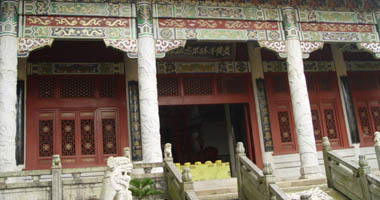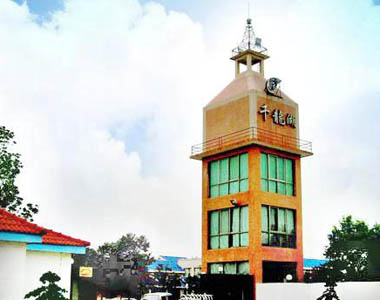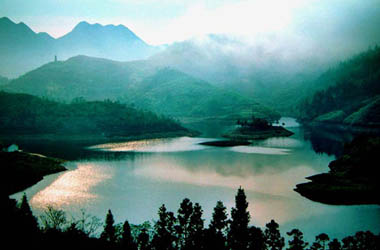
The Chinese people are proud of being descendants of Emperor Yan and Emperor Huang, who respectively ruled the Yangtse River valley and Yellow River about 5,000 years ago. They both made great contributions to their primitive tribes and are looked on as the revered ancestors of the whole nation.According to legend, Emperor Yan \"Invented\"spade-shaped plough, taught his subjects how to do farm work, tasted various herbs, made medicines, wove hempen cloth and set up markets.\"Late in his life, he continued to serve his people by treating their diseases and, unfortunately, died of tasting poisonous herbs in Ling County. Admiring his merits and virtues, his posterity built the Ancestral Temple to Emperor Yan at his burial mound in 967. Since then, in important ceremonials, sovereigns of every later dynasty would always tell envoys to visit the temple and offer sacrifices. Ruined several times in wars, it was rebuilt in the Qing dynasty(1616-1911). Yet, in 1954, it was burnt down. In October, 1985, the provincial government approriated a large sum of money and ordered the construction of the Mausoleum of Emperor Yan at the former site in Ling County. Now it has been a sacred place where the Chinese people pay homage to their ancestor.The front gate is called the Meridian Gate since our ancestor enjoys supremacy even unchallenged by sovereigns. It is flanked by partitioned rooms that house dozens of steles inscribed with funeral orations of varous dynastied . Beyond the gate, the vermillion steps lead to the Salute Pavillion, where worshipers are supposed to stop and give a salute before entering the main hall. Behind the pavillion unfolds three marble ramps carved in relief with patterns of invertwining clouds and dragons. They are fixed between six flights of marble steps that climb up the three-tiered terrace. High on the terrace stands the main hall, a finely decorated building with a hipped and gabled roof of double eaves. It houses a golden statue of Emperor Yan siting behind a basketful of crops, with a bunch of rice ears in the left hand and a medicinal herg in the right hand. Behind the hall is a pavillion, in which the grave stone is erected; and further on, the resting place of our revered ancestor lies in the rear of the courtyard. These major buildings, distributed one after another along the central axis, are symmet-rically flanked by minor buildings, such as the Sage-Worshiping Temple the Loft Virtues Archway, the Animal- Sacrificing Pavilion and the Harvest-Singing Terrace.Surrounded by towering old trees, the mausoleum seems all the more stately and splendid, with the golden roof s flashing brilliantly in the sun and the purple walls occasionally from behind the lush trees. The Emperor Yan\'s Mausoleum CeremonyChinese people are proud of being descendants of Emperor Yan and Emperor Huang, who, respectively, ruled the Yangtse and Yellow River vallies, about 5,000 years ago. As the legend goes, Emperor Yan went south to find herbs to treat his people. Unfortunately he ate some poisonous herbs, and died. In 967, in admiration of his merits and virtues, the Ancestral Temple was built, for him, at his mausoleum, which is at the foot of a mountain in Zhuzhou City, Hunan Province.According to historical records, people have performed sacrificial rituals in honor of Yan, since the Han Dynasty (206BC-AD220). There are a variety of activities in the ceremony, including offering objects or animals, playing music, and dragon dance performances, among others.The memorial ceremony has two types; the official and the folk, both of which have been preserved from ancient times. According to historical records, the grand ceremony was held 15 times during the Ming Dynasty (1368-1644), and 38 times during the Qing Dynasty (1644-1911).During its long history, the ceremony performed at Yan\'s mausoleum has become a culture with its own music, dance and literature. To commemorate Yan\'s discovery and use of fire, nine dragons are set alight, on stage. These then ignite the top firestone with the flames spouting from their mouths. The performance symbolizes that the Chinese people are descendants of dragons. In the square of the divine dragon hall, yellow, cyan,black, white, and red dragons perform according to the five different orientations, an embodiment China\'s rich traditional culture. Since China\'s reform and opening up in 1979, emperor Yan\'s mausoleum has become a prominent cultural artifact, and taking part in the rituals has become an important way of expressing patriotic sentiment, for many Chinese. In recent years, more than 100,000 overseas Chinese have come back to take part in the annual event. Attractions:Although we can\'t work out when Emperor Yan Mound was first built, according the records of history books, it must have been built before the Five Dynasty. In 967 A.D., Emperor Taizong of Song Dynasty assigned people to build a temple in front of Emperor Yan\'s Mound and Emperor Kangxi and Emperor Daoguang of Qing Dynasty also assigned officials to stand gravestones here. Emperor Yan is o?ne of the ancestors of Chinese people, he and Emperor Huang are called Yanhuang.Emperor Yan\'s Mound tourist zone includes human sight as Emperor Yan\'s Mound, Emperor Yan Temple, Fengshen Temple, Congde Lane, Huzhenguan Temple, Luyuan Kiosk and Holy Fire Dais, and natural sight such as Luyuan Cave, Dragon Head Stone, Dragon Claw Stone and Flower Washing Pool, all of them are very attractive.Emperor Yan\'s Mausoleum Scenic AreaSituated on Luyuan Slope west of Yanling County, it is a national AAAA scenic area. Among the tourist attractions in the scenic area, the most important one is Emperor Yan\'s Mausoleum which is a State Preservation Unit of Key Historical Relics and a national AAAA tourist zone. The mausoleum was built in 967 AD during the North Song Dynasty to commemorate Emperor Yan, one of the earliest ancestors of the Chinese people. In 2005 it was listed in the Top Ten Cultural Relics of Hunan Province. Other attractions include Emperor Yan Temple,Chongde Memorial Archway, Luyuan Pavilion, Saint Fire Terrace and Luyuan Cave. Over the past hundreds of years, sacrificial ceremonies have been held in front of Emperor Yan\'s Mausoleum. Now it is a sacred place for all the descendants of Emperor Yan and Huang in the world to seek their roots and pay homage to their earliest ancestors.Emperor Yan’s Mound is 6 m high and the diameter of its bottom is 27 m long. In front of the mound stands a gravestone set up by Emperor Daoguang in Qing Dynasty, writing the epigraph “Emperor Yan Shennongshi’s Mound”. In 1986, when the repair construction was finished, president Hu Yaobang also wrote a epigraph “Emperor Yan Shennongshi’s Mound”, which was carved into the white marble gravestone standing in the center of gravestone kiosk in front of the mound. All the Mound zone is surrounded by high mountains and Mishui River flows under the mountains, so the environment here is very quiet and peaceful.Travel tips:Zhuzhou enjoys humid monsoon climate in subtropical zone. The four seasons are distinct; the rain and heat is abundant with 286 days of frost-free period. The annual average temperature falls between 16℃ and 18℃. The four seasons are suitable for traveling, especially spring and autumn.If you go to Emperor Yan\'s Mound Tourist Zone to sacrifice Chinese people\'s ancestor, Shenlongshi, think of his great deed in tasting various herbs and recall his benefaction, you will have a feeling of thankfulness and bring a pure deep love to our people and nation.TrafficThe mausoleum of Emperor Yandi is in Luyuan Slope, 19 kilometers west of Yanling County, Hunan Province.You can take a bus to Zhuzhou city from Changsha.Then Take scheduled bus in Zhuzhou City to Yanling County. Then take a bus to Emperor Yan\'s Mausoleum and get off at Yandi Emperor Mausoleum arch, take the local bus, the fare is $3 or 4, the fare of taxi is $20-30.Admission (for reference): RMB 45yuan /adultTel: (86)731-26100857Yandi Mausoleum fee and opening hourTicket : 15 yuanOpening hours: 08:00-17:30Tips1.If you go to Emperor Yan\'s Mound Tourist Zone to sacrifice Chinese people\'s ancestor, please keep silent and dignified.2.please respect Chinese cultural monument, do not scrawl randomly and touch them with your hands.
Changsha & Zhuzhou & Xiangtan
2010-10-05 19:40
View:7205

Thousand-Dragon Ecosystem Vacation VillageThousand-Dragon Ecosystem Vacation Village is located at Getang Town, Wangcheng County, and it is 30 kilometers from Changsha City. The vacation village was built in 2002, and opened officially on July 1, 2004. It covered an area of 3,066 mu. There are 8 facilities which cost 180 million RMB: hotel, conference center, fishing pond, water sports center, leisure zone, fish feeding, vegetable land and young trees center. Hotels hold villas, luxurious and standard rooms, and altogether there are over 3,000 beds, and the hotel can hold the largest capacity of 800 people to have dinner.The vacation village has won prizes such as “national scenery zone”, “agriculture tourism experiment”, “international dragon-boating race standard zone”, “five-star eco farm”, “new 8 Xiaoxiang scenery spots”. In 2005, 2006 and 2007, China Wangcheng Thousand-Dragon Lake International Dragon-boating inviting contest, first and second Changsha Countryside Travel Festival, National Fishing Champion of 2007 held at this vacation village one after another. \"Thousand dragons are dancing with morning clouds, and the lake and the sky share the same color\". Thousand-Dragon Lake is a complex for business meeting, vacation and sightseeing. When you are at Bamboo Garden and view, you will find the lake is like a mirror. Dragon Poem House once held the evening party \"Taiwan, our family member\". Water restaurants hand down the cuisine culture of Xiang dishes. While when you play tennis, ping-pong and ride water bike and motor, you will feel young and energetic.The vacation village is becoming the countryside tourism engine within 3 years under the leadership and management of Mr. Chen Xinghua. This is Shangri-la for people.
Changsha & Zhuzhou & Xiangtan
2010-10-04 20:52
View:5809







